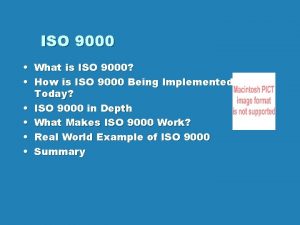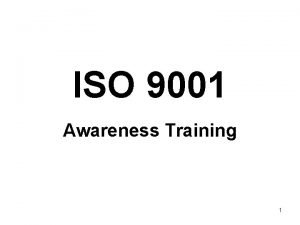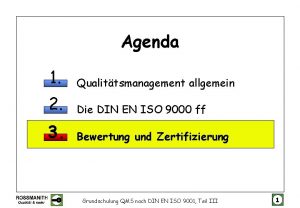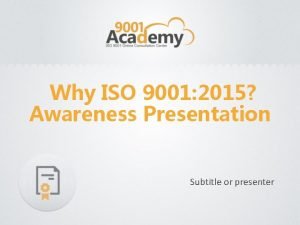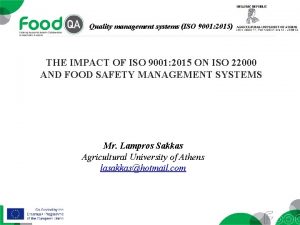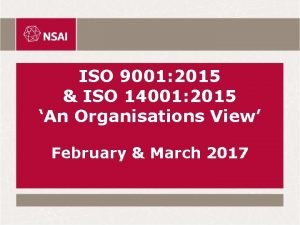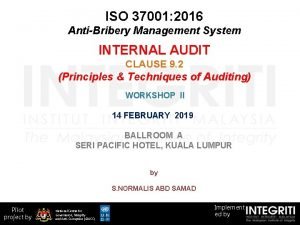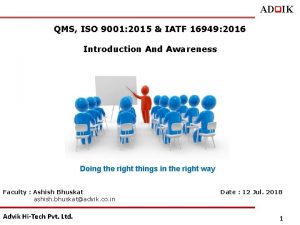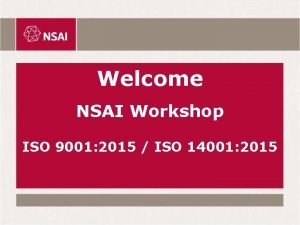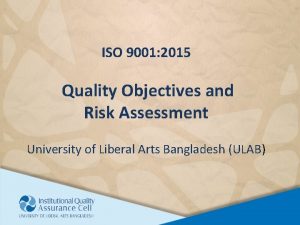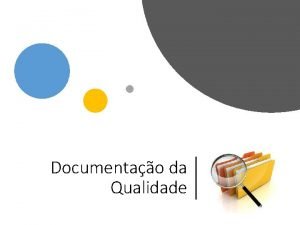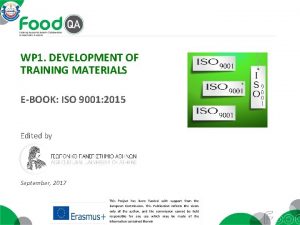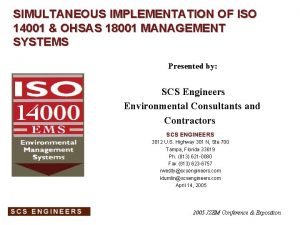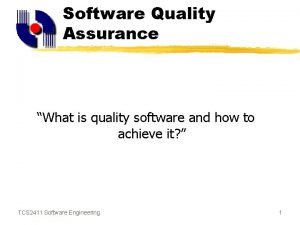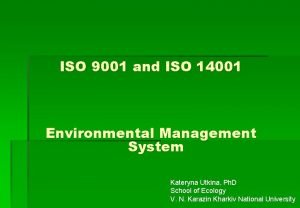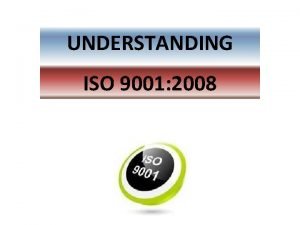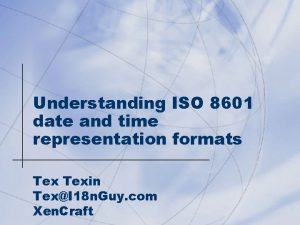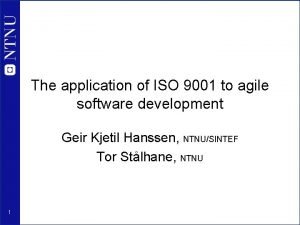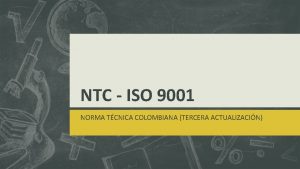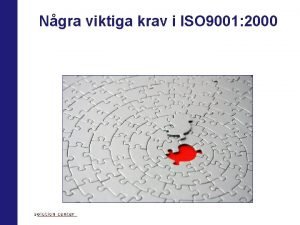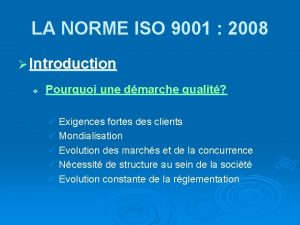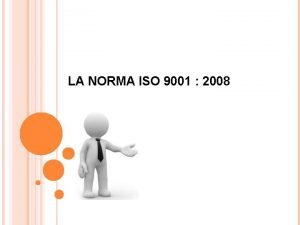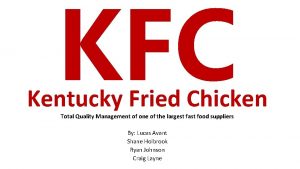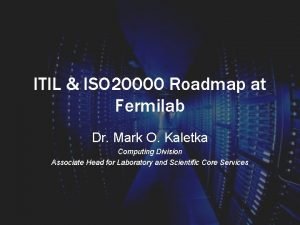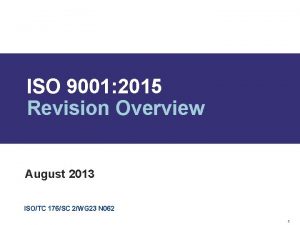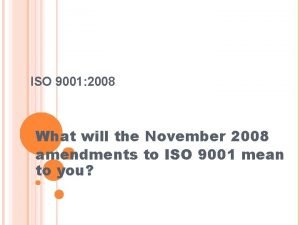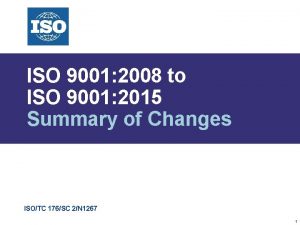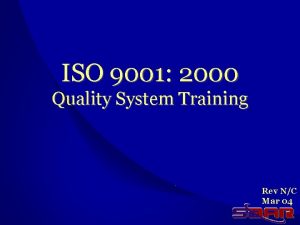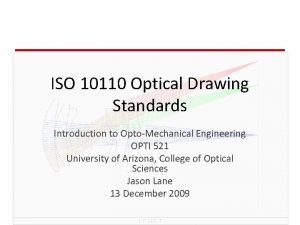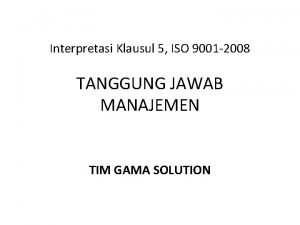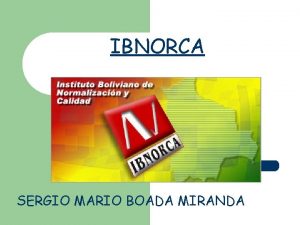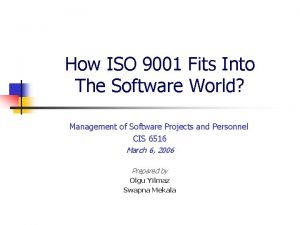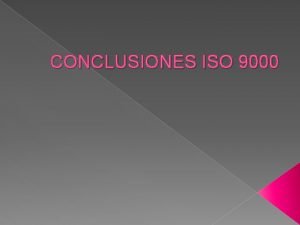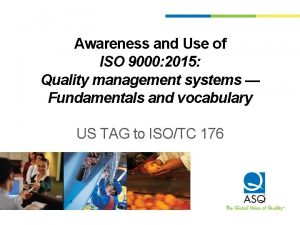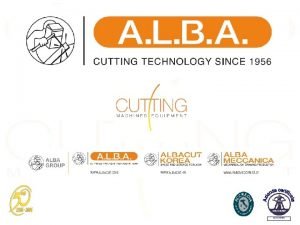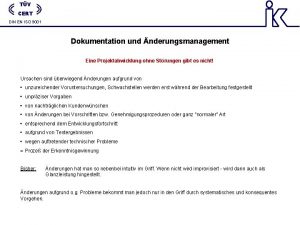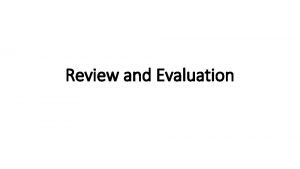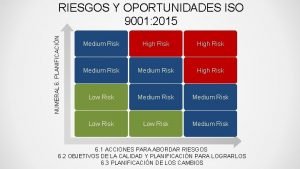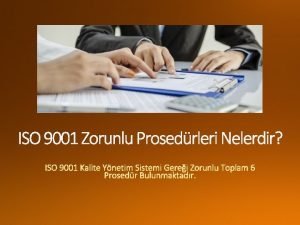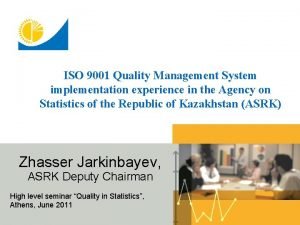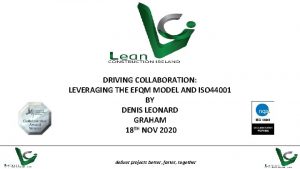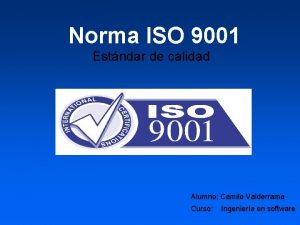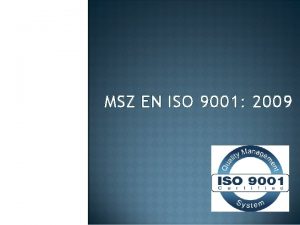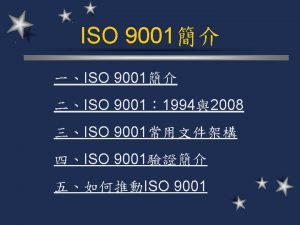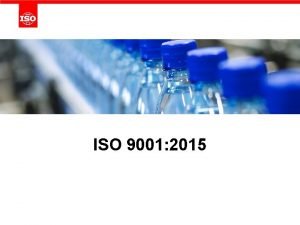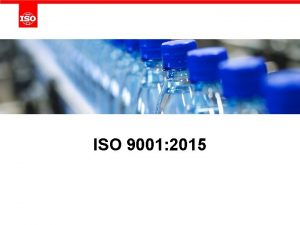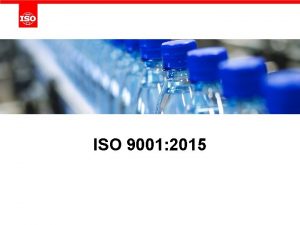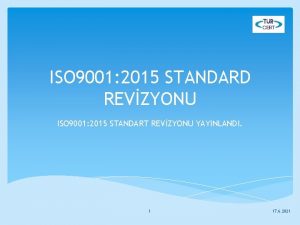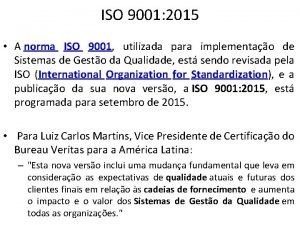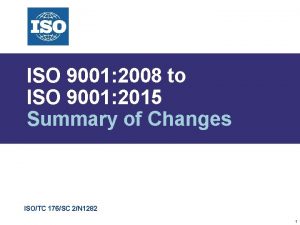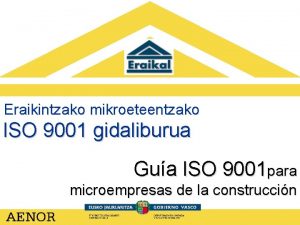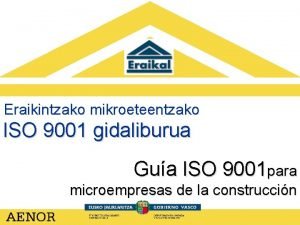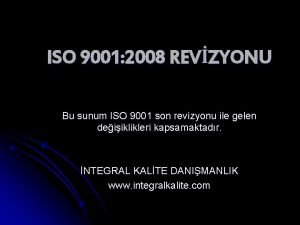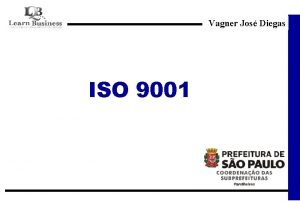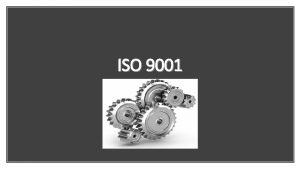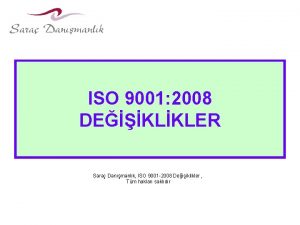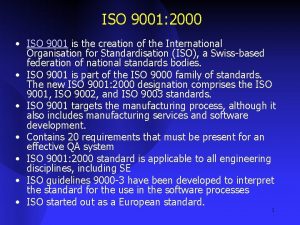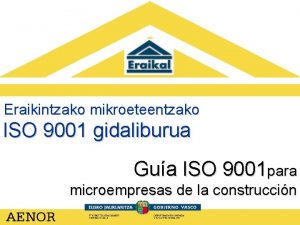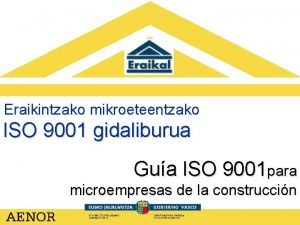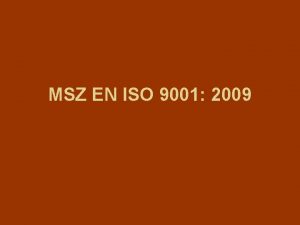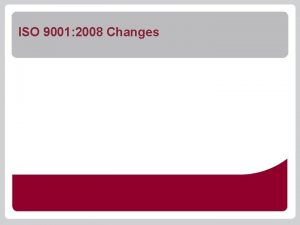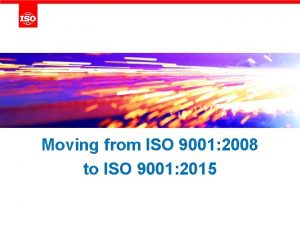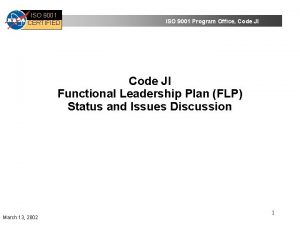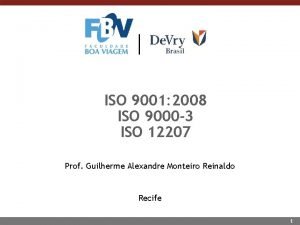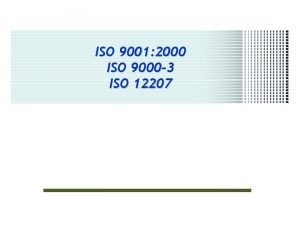Quality management systems ISO 9001 2015 THE IMPACT













































- Slides: 45

Quality management systems (ISO 9001: 2015) THE IMPACT OF ISO 9001: 2015 ON ISO 22000 AND FOOD SAFETY MANAGEMENT SYSTEMS Mr. Lampros Sakkas Agricultural University of Athens lasakkas@hotmail. com

Quality management systems (ISO 9001: 2015) THE IMPACT OF ISO 9001: 2015 ON ISO 22000 AND FOOD SAFETY MANAGEMENT SYSTEMS Mr. Lampros Sakkas Agricultural University of Athens lasakkas@hotmail. com

Outline 1) The Impact of ISO 9001: 2015 on ISO 22000 and Food Safety Management Systems • Food Safety Management Systems/Definition of ISO 22000 • Impact of ISO 9001: 2015 on ISO 22000 2) Basic steps towards implementing the system • ISO 9001: 2015 implementation steps • Transition from ISO 9001: 2008 to ISO 9001: 2015

Learning outcomes The trainee/student will: - understand purpose and benefits of a Food Safety Management System - understand purpose, benefits and structure of ISO 22000: 2005 - understand purpose, benefits and structure of revised ISO 22000 as an impact of ISO 9001: 2015

Food Safety Management Systems What is food safety? → assurance of food hygiene & harmlessness to consumers What is a Food Safety Management System? → systematic approach for ensuring food safety

Food Safety Management Systems HACCP → originated in the 1960 s (NASA, Pillsbury, US Army Laboratories) → 1 st manual was developed in 1973 (Pillsbury) → 1 st standard was published in 1989 (US NACMF) → + 5 preliminary steps + PRPs → FSMS concept was born

Food Safety Management Systems ISO 22000: 2005 BRC Global Standard for Food Safety (BRC) IFS Food (Retailer association of Germany -HDE- and France –FCD- and the contribution of the Italian associations -ANCC & ANCD) FSSC 22000 (Dutch Organization Foundation for Food Safety Certification) SQF Code (Food Marketing Institute in the USA) Dutch HACCP Code (Dutch National Board of Experts-HACCP)

DEFINITION OF ISO 22000 Food Safety Management System addresses what an organization needs to do to demonstrate its ability to control food safety hazards in order to ensure that food is safe at the time of human consumption and it can be used by any organization regardless of its size or position in the food chain (ISO, 2005) Key elements: 1) interactive communication 2) system management 3) prerequisite programmes 4) HACCP principles

DEFINITION OF ISO 22000: 2005 combines: HACCP + GMP + ISO 9001 Compatible with ISO 9001 What is Food Quality? Food Quality Assurance incorporates Food safety ISO 22000 → requires conformity with FS-related statutory & regulatory requirements → offers a more focused, coherent and integrated FSMS than is required by law

THE ISO 22000 FAMILY OF STANDARDS ISO 22000: 2005 ISO 22002 -1: 2009 → Prerequisite programmes on food safety - Part 1: Food manufacturing ISO/TS 22003: 2013 → Food safety management systems - Requirements for bodies providing audit and certification of food safety management systems ISO/TS 22004: 2014 → Food safety management systems - Guidance on the application of ISO 22000: 2005 ISO 22005: 2007 → Food safety management systems - Requirements for any organization in the food chain → Traceability in the feed and food chain - General principles and guidance for system design and development

ISO 22000: 2005 Benefits of implementing ISO 22000: 2005 Provide products safe for the consumer Ensure & demonstrate conformity to food safety policy Demonstrate compliance with legislation Communicate effectively food safety issues to the interested parties Improve hygiene & quality of the products Improve efficiency & process control Respond to customer demands – gain & maintain customer’s trust Enhance firm’s reputation – take advantage of a promotional/marketing tool Facilitate access to foreign markets

ISO 22000: 2005 Risk Based Management Model, from: Lokunarangodage et al (2016)

ISO 22000: 2005 combines: GMP + HACCP + ISO 9001 Effective Prerequisite Programmes → ensure a clean sanitary environment Hazard Analysis and Critical Control Plan → identify, prevent & eliminate FS hazards Management elements → manage food safety

ISO 22000: 2005 Three Layer Model of ISO 22000: 2005, from: Lokunarangodage et al (2016)

ISO 22000: 2005 Prerequisite Programmes (ISO 22002 -1: 2009 ) Construction and layout of building Management of purchased material Cleaning and sanitizing Layout of premises and workspace Utilities - air, water, energy Waste disposal Equipment suitability, cleaning and maintenance Measures for prevention of cross contamination Pest control Rework Personnel hygiene and employee facilities Product recall procedures Warehousing Product information Food defense, biovigilance and bioterrorism

ISO 22000: 2005 requirements Food Safety Policy Quality objectives Planning, designing & documenting a management system Implementing PRPs Documented procedure for handling withdrawal of product Control monitoring & measuring devices Records of system performance Food Safety Team & Team Leader Defining communication procedures Emergency plan Management review Adequate resources Following HACCP principles Traceability system Corrective action system & control of nonconforming product Internal audit program Continual update & improvement

IMPACT OF ISO 9001: 2015 ON ISO 22000 ISO 9001: 2015 → significant changes new concepts and approach more emphasis on process management/less emphasis on documentation ISO directive “Consolidated ISO Supplement” requirements for MS Standards: Ø high level structure Ø identical core text , common terms & definitions Aims of ISO 22000 revision: - increase compatibility with other MS standards - clarify key concepts - improve readability & usability - ensure relevance to the whole food chain • DIS 22000 published in March 2017, new version expected to be published in June 2018

IMPACT OF ISO 9001: 2015 ON ISO 22000 Impact of ISO 9001: 2015 - Major proposed changes to the ISO 22000 Standard 1. High level structure 2. Risk-based thinking 3. The PDCA cycle 4. Documentation 5. Terminology 6. Other changes

IMPACT OF ISO 9001: 2015 ON ISO 22000 High Level Structure • ISO 9001: 2015 → same overall structure as other ISO management system standards (High Level Structure) • Reviewing 22000 → High Level Structure → facilitates the implementation of multiple ISO standards • High Level Structure → ten clauses identical core text common terms & definitions • Impact on the system scope, top management involvement, documentation, application of the risk-based approach, clear focus on the process approach

IMPACT OF ISO 9001: 2015 ON ISO 22000 High Level Structure 1. Scope 2. Normative references 3. Terms and definitions 4. Context of the organization 5. Leadership 6. Planning 7. Support 8. Operation 9. Performance evaluation of the food safety management system 10. Improvement

IMPACT OF ISO 9001: 2015 ON ISO 22000 Risk-based thinking • The concept of risk has always been implicit in ISO 9001 2015 revision makes it more explicit, building it into the whole management system • Risk-based thinking → part of the process approach: ISO 9001: 2015 (4. 4 Quality management system and its processes) DIS 22000 (4. 4 Food Safety Management System) • DIS 22000/Introduction: concept & scope of risk-based thinking • Risk-based thinking → preventive action part of the company’s routine: ISO 9001: 2015 & DIS 22000 (6. 1 Actions to address risks and opportunities)

IMPACT OF ISO 9001: 2015 ON ISO 22000 Risk-based thinking • Risk management already considered in ISO 22000: 2005 (HACCP) • Risk-based thinking in now addressed in two levels: 1. Operational level (HACCP) 2. Strategic level of the management system (business risk) • New concept of business risk → will enable food companies to embrace opportunities • Implications: business planning management objectives identifying improvement opportunities allocating resources to reduce or eliminate unacceptable risk to food safety clarified approach to product withdraws and recalls

IMPACT OF ISO 9001: 2015 ON ISO 22000 The PDCA cycle • More emphasis on process approach, as in ISO 9001: 2015 (PDCA cycle) • DIS 22000/Introduction: process approach & PDCA cycle • Application of the PDCA cycle more clearly established • Two separate PDCA cycles instead of one • The two PDCA cycles will operate one inside the other: Ø one covers the overall food safety management system & Ø the other, within it, covers the operational processes → principles of HACCP

IMPACT OF ISO 9001: 2015 ON ISO 22000 Illustration of the two Plan-Do-Check-Act cycles, from: ISO/DIS 22000 (2017)

IMPACT OF ISO 9001: 2015 ON ISO 22000 PDCA cycle in ISO 22000: 2018, from: Willaert (2017)

IMPACT OF ISO 9001: 2015 ON ISO 22000 Documentation • ISO 9001: 2015 requires: information to be maintained or retained does not require: documented procedures & files • DIS 22000: Some mandatory documentation is still specified and it is expected that some documented processes could be required (due to the nature of FSMS) • DIS 22000: convergence of ‘procedures’ and ‘records’ into ‘documented information’ The organization is free to define the type & extent of documented information to be used • Established control for documents is retained • ISO 9001: 2015 does not require any longer a Quality Management Manual ISO 22000: 2005 did not include a requirement for a food safety manual

IMPACT OF ISO 9001: 2015 ON ISO 22000 Terminology • ISO 9001: 2015 → places more emphasis on leadership and management commitment → requires greater involvement by top managers and business leaders in controlling the QMS • Impact on DIS 22000: convergence of ‘management responsibility’ into ‘leadership’ – Role of top management is emphasized – Overall responsibility of top management is retained • Clear description of the differences between key terms: – Critical Control Points (CCPs) – Operational Prerequisite Programmes (OPRPs) – Prerequisite Programmes (PRPs)

IMPACT OF ISO 9001: 2015 ON ISO 22000 Context and Scope • New version of ISO 22000 will require organizations to consider upstream and downstream issues affecting customers and consumers as well as providers of products and services • New requirements concerning the context of the organization • Context will have to be formally documented • Impact on the scope of the FSMS

IMPACT OF ISO 9001: 2015 ON ISO 22000 Planning • Planning to achieve the FSMS objectives • Planning of changes Support • Communication control → clarified & strengthened • Tighter control of providers & subcontractors • Competence & awareness

IMPACT OF ISO 9001: 2015 ON ISO 22000 Operation • DIS 22000 requirements clarify the role of PRPs, OPRPs and CCPs in the FSMS • ISO/TS 22002 -X must be considered in the determination of PRPs • Records for the selection, establishment, applicable monitoring & verification of PRPs • Traceability & emergency response are tightened up: – Traceability system → tested & verified for its effectiveness – “Preventive action” → deal with potential emergency situations & incidents • Process environment for hazard analysis → seasonal changes or shift patterns are considered

IMPACT OF ISO 9001: 2015 ON ISO 22000 Operation • Control measures → categorized as OPRPs or CCPs – OPRPs → measurable and/or observable action criteria – CCPs → only measurable critical limits that enable timely correction • Hazard Control Plan includes → 1. HACCP plan → 2. OPRP plan • FSMS deals with OPRPs & CCPs in similar ways • Verification activities → performed by independent personnel

IMPACT OF ISO 9001: 2015 ON ISO 22000 Evaluation and Improvement • Requirements for performance evaluation retained • Greater emphasis on the use of a more integrated, systematic approach • Evaluation outcomes → prevention of failure → improve FSMS effectiveness

Correspondence between QMS ISO 9001: 2015 & FSMS ISO/DIS 22000: 2017 (1)

Correspondence between QMS ISO 9001: 2015 & FSMS ISO/DIS 22000: 2017 (2)

Correspondence between QMS ISO 9001: 2015 & FSMS ISO/DIS 22000: 2017 (3)

IMPACT OF ISO 9001: 2015 ON ISO 22000 major changes concerning clauses • • • 5. Leadership 6. 2. Objectives of the food safety management system and planning to achieve them 7. 1. 6 Control of externally provided processes, products or services 8. 2 PRPs 8. 3 Traceability 8. 4 Emergency preparedness and response 8. 5. 1 Preliminary steps to enable hazard analysis 8. 5. 2 Hazard analysis 8. 5. 4 Hazard control plan (HACCP/OPRP plan) 8. 8. 1 Verification

9001: 2015 IMPLEMENTATION STEPS How I can get started PDCA Cycle in correlation to ISO 9001 clauses, from: Tsakalou and Papakonstantinou (2017) * Clause 4 Context of the organization, Clause 5 Leadership, Clause 6 Operation, Clause 7 Support

9001: 2015 IMPLEMENTATION STEPS Steps to be undertaken Step 1 – Define the objectives of the organization Step 2 – Make sure senior management is on board Step 3 – Identify your organization’s key processes for meeting your objectives as well as your customers’ needs Step 4 – Buy the Standard and appoint a Quality Manager and the Quality team

9001: 2015 IMPLEMENTATION STEPS Steps towards certification • Evaluate whether certification makes sense for your organization • Main considerations: – Current level of conformance with ISO 9001 requirements – Amount of resources that the company will dedicate to this project for development & implementation – Amount of support that will be required from a consultant & the associated costs – Costs for ISO 9001 registration, surveillance & recertification audits

9001: 2015 IMPLEMENTATION STEPS Steps towards certification • Find a certification body. In doing so, you should: – build up a team and train the employees for the overall scope as well as the implementation processes – identify and evaluate as many certification bodies as possible – check if the certification body uses the relevant CASCO standard. ISO/IEC TS 170213: 2013 sets out the requirements for bodies providing audit & certification to QMS’s – check that the certification body is accredited (accreditation is not compulsory)

TRANSITION FROM ISO 9001: 2008 TO ISO 9001: 2015 1. Familiarize yourself with the new document 2. Baseline measurement 3. Plan of approach 4. Implementation 5. Training 6. Auditing and process analysis 7. Certification 8. Communication with interested parties

References 1. Escanciano C. , Santos-Vijande M. L. , 2014. Reasons and constraints to implementing an ISO 22000 food safety management system: Evidence from Spain. Food Control 40, 50 -57. 2. Fernandez-Segovia I. , Perez-Llazer A. , Peidro B. , Fuentes A. , 2014. Implementation of a food safety management system according to ISO 22000 in the food supplement industry: A case study. Food Control 43, 28 -34. 3. ISO 22000: 2015, Food safety management systems – Requirements for organizations throughout the food chain 4. ISO/DIS 22000: 2017, Food safety management systems – Requirements for any organization in the food chain 5. Lokunarangodage C. V. K. , Wickramasinghe I. , Ranaweera K. K. D. S. , 2016. Review of ISO 22000: 2005, Structural Synchronization and Ability to Deliver Food Safety with Suggestions for Improvements. Journal of Tea Science Research 6(2), 1 -12.

References 6. Silva M. M. , Fonseca L. M. , Sousa S. D. , 2016. The Impact of ISO 9001: 2015 on ISO 22000 and Food Safety Management Systems (FSMS). Quality, Access to Success 17(152), 81 -85. 7. Tsakalou L. , Papakonstantinou S. , 2017. How a company can get started and certified with the Standard, in: Quality Management Systems (ISO 9001: 2015), pp. 51 -57. Editor: Agricultural University of Athens. 8. Willaert T. , 2017. The revision of ISO 22000: An Overview of the coming changes. dqs-cfs. com/2017/02/revision-iso-22000 -overview-coming-changes/ 9. www. fao. org/fao-who-codexalimentarius/shproxy/es/? lnk=1&url=https%253 A%252 Fworkspace. fao. org%252 Fsites%252 Fcodex%252 FMeetings%252 FCX-712 -47%252 FCRD%252 FFH 47_CRD 12 x. pdf

Self-evaluation questions (1) What is a Food Safety Management System? (correct answer: It is a systematic approach for ensuring food safety) (2) The expected impact of ISO 9001: 2015 on ISO 22000 includes: A. Structure of the Standard B. Terminology C. Documentation D. All above (correct answer: D) (3) In line with ISO 9001: 2015, the new version of ISO 22000 is expected to: A. place less emphasis on process approach B. place more emphasis on management commitment C. include a requirement for a food safety manual (correct answer: B)

Author(s) information Veterinarian MSc in Food Science and Nutrition Ph. D student in Food Science and Technology-Dairy Research Quality Assurance and Food Safety consultant Lampros Sakkas
 Used il acl 9000
Used il acl 9000 Awareness iso 9001
Awareness iso 9001 Management review iso 9001 version 2015 muster
Management review iso 9001 version 2015 muster Iso 9001:2015 ppt
Iso 9001:2015 ppt Major changes in iso 9001 for 2015
Major changes in iso 9001 for 2015 Objective of quality
Objective of quality Iso 37001 checklist
Iso 37001 checklist Iso 9001:2015 process interaction matrix
Iso 9001:2015 process interaction matrix Nsai iso
Nsai iso ıso 9001:2015 kalite el kitabı örnekleri
ıso 9001:2015 kalite el kitabı örnekleri Iso 9001:2015 risk assessment example
Iso 9001:2015 risk assessment example Controle de informação documentada iso 9001
Controle de informação documentada iso 9001 Ebook iso 9001 2015
Ebook iso 9001 2015 Ohsas 18001 iso 14001 comparison
Ohsas 18001 iso 14001 comparison Software quality assurance iso standards
Software quality assurance iso standards Iso 9001 environmental management system
Iso 9001 environmental management system Iso 9001 clauses
Iso 9001 clauses May 2002 calendar
May 2002 calendar Iso 9001 agile software development
Iso 9001 agile software development Norma tecnica colombiana iso 9001
Norma tecnica colombiana iso 9001 Iso 9001 krav
Iso 9001 krav Norme iso 9001 2008
Norme iso 9001 2008 Norma iso 9001: 2008
Norma iso 9001: 2008 Total quality management of kfc pdf
Total quality management of kfc pdf Itil iso 9001
Itil iso 9001 Iso 9001 introduction
Iso 9001 introduction Iso 9001:2008 certification in mumbai
Iso 9001:2008 certification in mumbai Iso 9001 summary
Iso 9001 summary Iso 9001 2000 training
Iso 9001 2000 training Iso drawing standards
Iso drawing standards Klausul 5 iso 9001
Klausul 5 iso 9001 Mario boada
Mario boada Iso stands for
Iso stands for Norma tl 9000
Norma tl 9000 Iso 9000 2015 pdf
Iso 9000 2015 pdf Uni en iso 9001 2000
Uni en iso 9001 2000 änderungsmanagement iso 9001
änderungsmanagement iso 9001 Iso 9001 customer satisfaction
Iso 9001 customer satisfaction Iso 9001 kapitel 8
Iso 9001 kapitel 8 Oportunidades iso 9001
Oportunidades iso 9001 Iso 9001 zorunlu prosedürler
Iso 9001 zorunlu prosedürler Iso 9001:2012
Iso 9001:2012 Fiche processus ressources humaines pdf
Fiche processus ressources humaines pdf Iso 4401 collaboration
Iso 4401 collaboration Iso 9002 wikipedia
Iso 9002 wikipedia Iso 9001 2009
Iso 9001 2009
